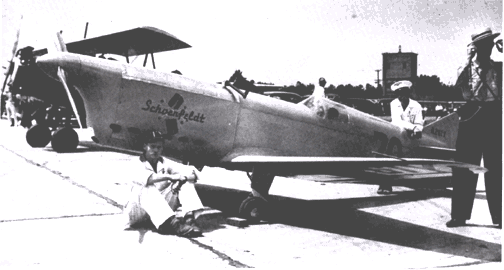
Ryder-Firecracker-racer - $$4.95
Keith Rider's earlier racers were monocoque construction and the R-4 was steel tubing, with a wood fairing covered with fabric. The plywood covered wing used a symmetrical airfoil and the landing gear had a wide tread and folded inwardly with a manual retracting mechanism.
The Keith Rider R-4 Schoenfeldt Firecracker 1938 Racer
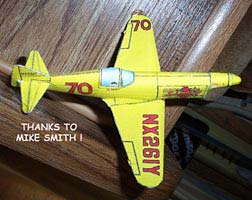 Rider made a series of 6 or 7 racers-all evolvements of the one
winning design. There are only two in our collection, the R-4 and
the R-6 but you can read about the others in the 'information' section.
Rider made a series of 6 or 7 racers-all evolvements of the one
winning design. There are only two in our collection, the R-4 and
the R-6 but you can read about the others in the 'information' section.
Keith Rider had a new small racer at the 1936 Nationals. It was
the R-4 and it was a departure from the former Rider racers. His earlier
racers were monocoque construction and the R-4 was steel tubing,
with wood fairing covered with fabric. The plywood covered wing
used a symmetrical airfoil and the landing gear had a wide tread
and folded inwardly with a manual retracting mechanism.
The racer had an 18 ft. wing span and a length of 19 ft. 6 in. It
weighed only 925 lbs. empty and 1325 lbs. loaded. Painted a bright
yellow, it carried reg number NR-261Y, race number 70 and was powered
by a Menasco B6S Buccaneer 489 cu. in. displacement engine.
KEITH RIDER R-4
Keith Rider had a new small racer at the 1936 Nationals. This was the R-4 and was a departure from the former Rider racers. His earlier racers were monocoque construction and the R-4 was steel tubing, with wood fairing covered with fabric. The plywood. covered wing used a symmetrical airfoil and the landing gear had a wide tread and folded inwardly with a manual retracting mechanism. The racer had an 18 ft. wing span and a length of 19 ft. 6 in. It weighed 925 lbs. empty and 1325 lbs. Loaded.
Painted a bright yellow, it carried license number NR-261Y, race number 70 and was powered by a Menasco B6S Buccaneer 489 cu. in. displacement engine. Roger Don Rae, who had raced the Rider R-1, was pilot of the new job. Roger, as always, turned in an impressive performance at the 1936 Nationals. He won the 550 cu. in. Shell Speed Dashes with a speed of 225.544 mph, and then really polished the pylons to finish third in the Thompson Trophy Race with a speed of 236.559 mph. He finished fifth and sixth in two 550 cu. in. Greve Events with speeds of 212.325 mph and 218.155 mph.
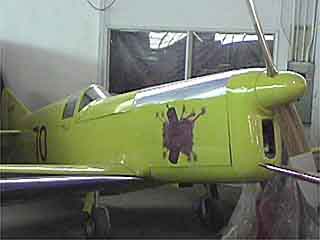 |
Bill Schoenfeldt acquired the R-4 in late 1936 and hired the original crew who had built her to rebuild the racer. He replaced the B6S Buccaneer engine with a new Menasco C6S-4 Super Buccaneer. This was a six cylinder 544 cu. in. displacement engine built for racing. Many cooling problems were experienced as the crew was not satisfied with the engine and wanted it to wrap even tighter than the factory had set it up.
The engine itself was longer and presented a CG problem. These were all worked out and the engine was tuned to turn 3500 rpms. The racer was renamed the "Schoenfeldt Firecracker" and had its first taste of competition at the 1937 International Air Races in St. Louis. With Gus Gotch as the pilot, the racer placed second behind Marion McKeen and the Brown "Miss Los Angeles". Their speeds were 239.9 mph and 240.0 mph . . . almost a dead heat.
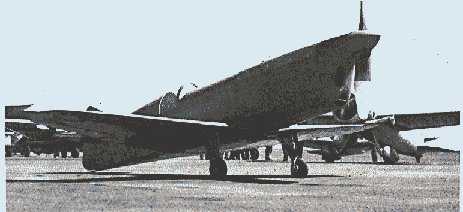
After this race Gus nosed the plane over during the landing roll. This eliminated the racer from the next day's races, but Schoenfeldt had a prop sent from the Story-Gawley Co. in Los Angeles. The prop was the most serious part damaged and one was flown in during the night. However, when the prop arrived it was found that it was drilled for the older Buccaneer engine. Ole Fahlin, of the Fahlin Propeller Co., was at the races and came to the rescue. He flew the prop to his plant at Marshall, Missouri, and had it redrilled and balanced. So with the bent cowl and air scoops the number 70 was ready for the last day of the races. This was May 30 . . . Memorial Day . . . and the race was the feature race . . . the Missouri Brewer's Association Trophy Race.
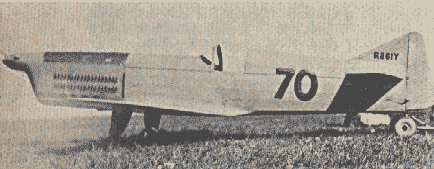
Gotch got off to a slow start and loafed for a few laps then opened the throttle on the "Firecracker" and went on to win the event with a speed of 251.6 mph. A few of the laps he turned at 260 mph. After the race the R-4 was returned to Los Angeles where the damage to the cowling and air scoop were repaired and an extra tank for the Thompson Trophy Race added. At the Nationals Gotch had further troubles but managed to pick up a third in the Greve Race (231.59 mph), and seventh in the Thompson at 217.81 mph.
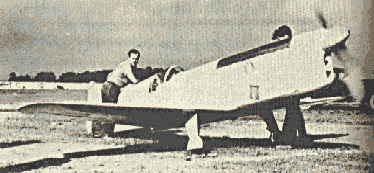
During 1938 the "Firecracker" was again reworked and made a fine showing at the International Air Races in Oakland, California. Tony LeVier raced home winner in two events and third in another. His best pylon speed was 260.762 mph. LeVier was now ready for the competition at the Nationals and hoped for wins in both the Thompson and Greve races. He won the Greve Race moving around the pylons at a speed of 250.89 mph.
Art Chester in the "Goon" finished only five seconds behind him. It had been a see-saw battle all the way and the lead had changed many times. Elated by his winning. Tony landed downwind and at his approach speed of 150 mph, he overshot the main runway and hit a cross runway. The racer nosed up and the impact broke both wing spars splitting the plywood covering from tip to tip. This eliminated the "Firecracker" from the Thompson Trophy Race.
It was back to the shop and another rebuild job. But plenty of time existed before the 1939 Nationals. By the time the big show for 1939 rolled around the racer was .again in top shape. It still retained its yellow paint job, race number 70, and Tony LeVier as pilot. During and before the Greve many mishaps narrowed the race field. The race ended up being a contest between Chester and LeVier. The "Firecracker" engine began to misfire on the 11th lap and Tony was forced to withdraw. This was not the end of his trouble. During the Thompson, LeVier had taken the lead on the fifth lap but was unaware of this and throttled back when Turner passed him. Tony thought Turner was lapping him and he wanted to save the engine. Had he not throttled back he could have won the Thompson. He did finish second with a speed of 272.588 mph as opposed to Turner's 282.586 mph.
The "Firecracker" went into storage at the start of World War II and has since been cannibalized for parts needed for other aircraft.
MORE ABOUT KEITH RIDER>>>>
KEITH RIDER, a name destined to become famous in race circles, had his first racing aircraft at the 1930 National Air Races. This was the Rider B-1. It was all wood in construction, had very clean lines, and had been built with a retractable landing gear. However, time did not permit completing the retracting mechanism so it appeared at the races with a fixed gear. The little racer had a wing span of 20 ft., length 19 ft. 6 in., wing area 60 sq. ft. and tipped the scale at 875 lbs. fully loaded. It was powered by a Menasco Pirate engine that pulled the Clark Y airfoil through the air with ease.
Looking much like the later Rider racers, it carried license number NR-10216 and wore race number 123 on its flanks. Major John A. Macready of the Army Air Corps Reserve, who had flown many of the Air Service racers and made the famous Fokker T-2 cross country flight, was the pilot for the races. However, during the first event (800 cu. in. free-for-all), the little racer lost an aileron and crashed. The ship was completely destroyed and only the tail section remained intact. Only small pieces of the racer remained after the crash but through some quirk of fate Macready emerged with only minor injuries. So ended the short career of the KeithRider B-1 racer.
Keith Rider was present for the 1931 National Air Races . .
. this time with two cigar-shaped racing planes. Both were finished
just a short period before the races. They appeared to be cleaned-up
models of the B-1 but were all metal in place of wood. The fuselages
were aluminum and monocoque in design. Both of these racers were
registered with the CAA as Rider R-1's but were always known as
the R-1 and R-2. No reason was ever given for the B-1 and later
switch to the R designation. The R-1 was designated 'San Francisco
1", licensed R-51Y, race number 131, and powered with a 544
cu. in. Menasco Buccaneer B6S engine rated at 260 hp. 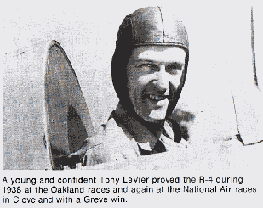
Its wing span was 21 ft. 4 in., chord 5 ft. at the fuselage and tapered to 2 ft. at the tip. This gave the racer a wing area of 65 sq. ft., wing loading 17.5 and a power loading of 4.6 lbs. per brake hp. The sleek little cigar-shaped racer was equipped with a retractable landing gear that consisted of two stiff struts. The only shock absorbers were the air wheels and they proved to be rather effective. These wheels did not retract completely and it was possible to land gear up with minimum damage to the racer.
The racer was owned by the San Francisco Racing Group headed by Bob Clampett. Bob flew the ship at the 1931 Los Angeles Air Fiesta and won both the 800 and 1350 cu. in. free-for-all races. During these races he turned a speed of 183 mph on the pylons. The same year Ray Moore flew the racer at the Nationals. He won the 800 cu. in. event clocking at 185.09, mph and placed second in the 1000 cu. in race turning the course at 177.089 mph.
The R-1 returned to the Nationals in 1932. Only minor changes had been made on the racer. The large fairing on the top of the fuselage and forward of the windshield had been removed and a new fairing strip had been placed over the exhaust outlets which formerly extended into the airstream. The exhaust outlet was now flush with the external surface of the fairing, giving the cowl much cleaner lines. The racer retained its polished aluminum finish and the race number 131. Ray Moore again performed the cockpit duties, placing fi~st in the 800 cu. in. Phillips Race with a speed of 182.22 mph. Later he placed fourth in the 1000 cu. in. race turning the course at 179.2 mph. In the Shell Speed Dash he placed seventh with a speed of 237.74 mph. During the Nationals he also entered the Thompson Trophy Race and was forced out on the second lap. In the 68O cu. in. event he pulled out on the seventh lap.
The Rider R-1 flew into the 1933 National Air Races at Los Angeles looking the same as it had in 1932. Even the pilot. Ray Moore, was the same. This time he took home one first t550 cu. in.- 189.63 mpht, four seconds 550 cu. in.- 191.58 mph . . . 190.90 mph . . . 186.23 mph and Shell Dash, 550 cu. in. - 231.70 mph), one fourth ~1000 cu. in.- 183.82 mph>, and placed fifth in the unlimited Shell Speed Dash with his speed of 231.70 mph. Later in 1933 at the International Air Races in Chicago, Steve Wittman tried his luck with 131. He placed the racer fourth in the 550 cu. in. race with a speed of 185.37 mph and dropped out on the fourth lap of another 550 cu. in. race when the oil tank exploded.
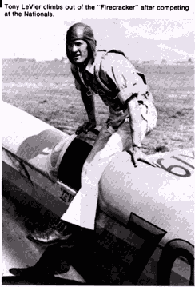
The year 1934 saw old number 131 racing under new colors. Rudy Kling, garage owner from Lemont, Illinois, now owned the racer. The windshield was rounded off, eliminating the square corners of the original windscreen. The racer still retained the race number 131, but was now known as the 'San Franciscan". Roger Don Rae took over the pylon polishing duties for the Nationals and picked up two seconds ~ 550 cu. in.-204.77 mph . . . and 211.0 mph>, a third in the Shell Speed Dash (235.34 mph~, and two fifths t1000 cu. in.- 195.52 mph) and the Thompson Trophy Race (205.36 mph). The modifications helped the speed of the racer some, but the big speed increase was from the skillful hands of Rog Don Rae on the pylons. Rae did encounter a mishap when the landing gear failed during a landing, however, only m~nor damage was done to the prop and underside of the fuselage.
During late 1934 and early 1935 Rudy Kling worked on the racer at his garage in Lemont. During this time he made several modifications on it. The cooling louvres on the left side of the cowling, which had been blocked off, were again open. This perhaps was done with the idea of winding the engine tighter and using the extra cooling for the oil and cylinders. Rae was again in the cockpit for the Nationals and again turned in an amazing performance with the racer. He picked up a second and third in the 550 cu. in. Greve Races (210.13 mph and 200.83 mph), and a third in the Thompson Trophy Race moving around the pylons at 213.94 mph.
In 1936 Kling gave his racer a major clean-up job. Along with this he included a new name, "Suzy", and trimmed the blue fuselage with cream paint. The entire r acer sparkled with a high gloss finish. Kling had included a new nose cowl, a prop spinner, and the cockpit was completely enclosed. The finished product was a much sleeker Looking racer and proved to be several miles an hour faster. Rudy chose to fly the racer himself in the 1936 Nationals, as Don Rae was flying the Keith Rider R-4. Kling placed second in the first 550 cu. in. event, turning in a speed of 236.44 mph and a fourth in another at a speed of 215.31 mph.
These speeds indicated that the racer was about 10 or 12 miles an hour faster than it was in 1935. The slower speed of the two races came about when Rudy realized that he had already established his position and no one was about to pass him and at this point he throttled back to save his steam for the Thompson Race. It was during the landing from this event that Joe Jacobson flipped Howard's "Mike" over. Don Rae darted between the crack-up and people to make a safe landing, but as Kling tried the same hole, a car had moved into the space. "Suzy" rammed right through the auto and was completely demolished. Somehow Kling emerged unhurt. So ended the history of the Rider R-1.
THE KEITH-RIDER RACER R-2
The other racer built by Keith Rider in 1931 was the R-2. This racer was also registered with the CAA as an R-1 but was commonly called the R-2. Named the "San Francisco 2" and carrying race number 132 on its flanks, it was licensed R-52Y. It looked just like its big sister, the R-1, but had a smaller wing span and engine. It was powered with a four cylinder C-4S Menasco Pirate 365 cu. in. engine rated at 125 hp and reworked to almost 200 hp.
Robert Clampett owned this racer (as well as most of the R-1) and did most of the racing with it. During their travels both racers were sponsored by Standard of California. In 1931 Ray Moore flew the silver racer in one event at the Nationals, winning first in the 400 cu. in. event with a speed of 156.456 mph.
In 1932 Bob Clampett flew the R-2 from Los Angeles to Omaha and participated in the races. In one of the feature races Bob beat out Benny Howard in the "Mike" to win with a speed of 176.06 mph, as opposed to Howard's speed of 176.04 mph. This race was wing to wing for the entire course and a photo finish. From here Clampett traveled to Cleveland for the Nationals. There he placed fifth in the 510 cu. in. event (159.78 mph), and sixth in the 800 cu. in. Phillips Race (163.65 mph). The decrease in speed from the Omaha races was engine trouble. Clampett flew both events at Cleveland with a cracked crankcase.
The R-2 zoomed into the 1933 Nationals at Los Angeles wearing a new race number, 1. Also a new name "Bumble Bee" replaced the "San Francisco 2". George McGrew, first husband of the famed movie star, Jean Harlow, now owned the racer. The name C. F. McGrew was painted on the rudder and the block race number I was painted inside a cream stripe around the fuselage just aft of the cockpit. Also a new engine cowl replaced the old one. This one had larger but cleaner designed air exit louvers on the side. There were no noticeable changes to the wing or airframe. Bob Clampett had taken a job as engineer with the Luscombe Airplane Company so George Hague was now piloting the "Bumble Bee
He picked up one first (375 cu. in.- 164.94 mph), two seconds (375 cu. in.-160.36 mph . . . 159.96 mph), two thirds (1000 cu. in.- 165.14 mph), (550 cu. in.- 166.13 mph), five fourths (550 cu. in.-171.22 mph . . . 172.03 mph . . . 172.34 mph), (375 cu. in .-forced out but placed fourth) . . . (Thompson Trophy Race . . . 183.21 mph), and one fifth in the Shell Speed Dashes with a speed of 210.12 mph. The speeds chalked up for the Thompson and the Shell Races were very impressive.
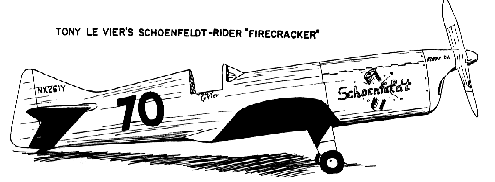
Later in 1933 the R-2 arrived at the International Air Races wearing a new bright red paint job on its fuselage. The bright fuselage was trimmed in yellow and the wings and horizontal tail surfaces were also yellow. The red race number I was placed over a yellow band just aft of the cockpit and a picture of a bumble bee appeared on either side of the fuselage just forward of the cockpit. At different times during the season of 1933 the Richfield gasoline emblem appeared on the rudder, as did the Shell emblem on the headrest, and the Kendall emblem on the cowl. Hague departed the International Air Races, taking with him three thirds (375 cu. in.- 160.35 mph . . . 170.35 mph . . . 171.07 mph), and one fourth (550 cu. in.- 168.26 mph). He dropped out of another 550 cu. in. event on the sixth lap with engine trouble.
The R-2 was again present for the 1934 Nationals. No visible changes had been made to the racer. Earl Ortman did the flying for these races and placed third in the 375 cu. in. event (159.06 mph), and fourth in two other 375 cu. in. races (159.52 mph . . . 181.20 mph).
The little "Bumble Bee" did not appear again at the National Air Races until 1938. It was still owned by C. F. McGrew and was slightly modified from the 1934 version. The propeller sported a new spinner, the paint job was once again aluminum, a new windshield and canopy had been added, and the cockpit was completely enclosed. The headrest was faired into the fuselage making the aft portion deeper. The racer picked up a new license number of NX98X (to replace NR52Y), and a new race number 17. It was now known as the "BusheyMcGrew Special" and George Dory, Los Angeles, was the pilot. During the Greve Trophy Race Dory was flying close to the ground when the Menasco threw a rod. He lowered the landing gear and set the racer down on 227th St. (near Lorain Ave.), in Cleveland. The wings sheared and the engine broke loose as he threaded the plane between trees. The R-2 was completely destroyed and Dory was seriously injured. This was the third Keith Racer built and the third to end with a crash.
KEITH RIDER R-3
Keith Rider and his associates sold the two smaller racers in 1934. This was to make room for a larger racer. They were going after bigger money at the Nationals and also the London to Melbourne Mac-Robertson Race. Like the R-1 and R-2, the R-3 was an all metal cantilever low wing monoplane with retractable landing gear. It was powered with a 1340 cu. in. Wasp Sr. engine rated at 750 hp and was enclosed by a bulge NACA type cowl. Its wing span was 25 ft. and length 21 ft. 8 in. Its empty weight 1800 lbs. and grossed at 2970 lbs. As the R-1 and R-2, it appeared in 1934 with aluminum skin, unpainted.
The racer was licensed NR14215 and had race number 9 painted on its flank. Jim Granger was chosen as pilot for the 1934 Bendix Race but was forced out. Granger was killed when the racer nosed over during take-off. The plane did not have enough prop clearance and as the propeller dug in, the racer nosed over pinning Granger under the plane. The R-3 was rebuilt, as damage to the racer itself was only minor. After it was rebuilt, Vance Breese flew the R-3 for a time intending to set a few world speed records before the 1935 National Air Races, but many minor problems prevented this.
The R-3 was ready for the 1935 Nationals. The cock pit was now enclosed and the racer had a new paint job. Other than these changes the R-3 appeared to be unchanged from 1934. The race number 9 was still present but the pilot, Earl Ortman, was new. During the Bendix, and enroute to Cleveland, Ortman became lost between Albuquerque and Amarillo, Texas, delaying him so that he was no longer a threat in the race. Then as he set the silver bullet down for fuel in Kansas City, Ortman discovered cowling damage and withdrew from the race.
In 1936 Earl and his big Wasp powered racer was at the Nationals. Most of the bugs had been worked out of the racer and Ortman was ready for his share of the winnings. The R-3 was still sponsored by Gilmore and now possessed a new cream, red and gold paint job. It also possessed. a new race number, 54. Ortman gave Detroyat, from France, a rather poor bid in the Thompson Trophy Race and had to settle for second spot with a speed of 248.042 mph. Detroyat pushed his Caudron Racer around the pylons at 264.3 mph. During the 1936 season Ortman had set several speed records with the R-3. One of these was the Three Flags Record (Canada to Mexico). He flew this flight in 5 hours, 27 minutes, 48 seconds, bettering the old record of 6 hours and 40 minutes.
Earl roared back into Cleveland for the 1937 Nationals. The racer had been sold to Marcoux and Bromberg. They had reworked the R-3. One of the changes was the engine. The Wasp Sr. was replaced by a Twin Wasp Jr. of 1535 cu. in. displacement (195 more than the Wasp Sr.). The Twin Wasp, (Serial Number 422), S2A5G was built in 1936 and used as a test engine. It was overhauled in 1937 and delivered to Marcoux and Bromberg. Other changes were a new enclosed cockpit, smooth NACA engine cowl, cowl flaps, and a new wing. The paint job was a black fuselage and silver cowl, with yellow wings and horizontal tail surfaces. Its empty weight was now 2400 lbs. and grossed at 3470 lbs.
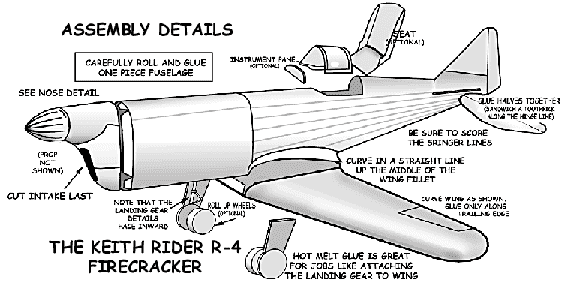
The R-3 also drew a new race number 4 and was now known as the "Marcoux-Bromberg Special". Ortman placed second in the Bendix (224.83 mph), and again second in the Thompson Trophy Race, but just by a matter of a few feet. Ortman had taken the lead in the Thompson after Wittman, who was leading by a wide margin, dropped back because of engine trouble and Roscoe Turner had missed a pylon and had to return to recircle it. The R-3 was radio equipped and Earl's ground crew advised him to throttle back as no one was close to him. Then out of nowhere came Rudy Kling and his little "Shetland-pony" racer. He dived his sleek little Folkerts Special over the finish line to edge out Ortman by 2/10Oths of a mile an hour. Kling's speed was 256.91 mph and Ortman's was 256.89 mph. Earlier Earl and the Marcoux-Bromberg had placed third in the Thompson qualifying runs with a speed of 247.98 mph.
Only minor changes were visible as the Marcoux landed at the 1938 National Air Races. Earl Ortman was still the pilot but the paint job and the race number was new. The paint job was all yellow and the race number 3. Ortman was determined to grab the Thompson Trophy. He took the lead in the Thompson, turning his Twin Wasp Jr. (rated at 700 hp at 2500 rpm and 36.6 in. HG for take-off only), 2675 rpm (125 rpm over maximum power), and pulling 48.25 in. HG (11.75 in. HG over max.).
This 2675 rpm and 48.75 in. HG lasted for 27 laps (270 miles), and at this point an oil inlet line ruptured and the oil pressure went to zero. Ortman throttled back but continued the race as only three laps (30 miles), remained. He finished, for the third year in second spot. This time his speed was 269.72 mph. He continued to increase his speed but never could improve his position. The engine continued to run during the balance of the Thompson and did not quit until the switch was cut. However, when the engine was inspected much damage was revealed and it was amazing that it had continued to operate the last three laps.
The yellow Marcoux was back for the 1939 races and Ortman was still in the cockpit. A ne l race number 2 had been picked up, perhaps to match his expected position in the Thompson Trophy Race. However, Earl finished third this year with a speed of 254.44 mph, about 15 mph slower than the R-3's 1938 speed.
The World War II years ended the racing career of the powerful and ever present Keith Rider R-3 racer but the ship still exists. It is now the property of the Bradley Air Museum.
KEITH RIDER R-5
The R-5 was another Keith Rider racer that appeared at the 1936 National Air Races. It was owned by Dave Elmendorf and was built similar to the R-4 but had 2 ft. more of wing span and was 80 lbs. heavier. Painted a cream yellow, licensed NX264Y, and carried race number 22 which Dave had used on his Wedell Williams racer in 1935. Elmendorf placed third in the 550 cu. in. event, turning in a speed of 224.551 mph.
The R-5 did not appear at the 1937 races but flew into the 1938 Nationals with a new paint job. The ship had been purchased by Marcoux and Bromberg and they had rebuilt but not modified it. It sported a black fuselage, with yellow wings and horizontal tail surfaces. It still retained race number 22 and was known as the "Jackrabbit". Earl Ortman flew this job and also the R-3 during the 1938 races. He placed fourth in the 550 cu. in. Greve Race with a speed of 192.50 mph.
The R-5 "Jackrabbit" was again present at the 1939 races, unchanged from the previous year, but the engine would not run properly and so the racer did not participate.
After World War II this racer was seen in front of a Chinese cafe in California . . . being used for advertising! Today "Jackrabbit" is restored and on display at the EAA Air.



